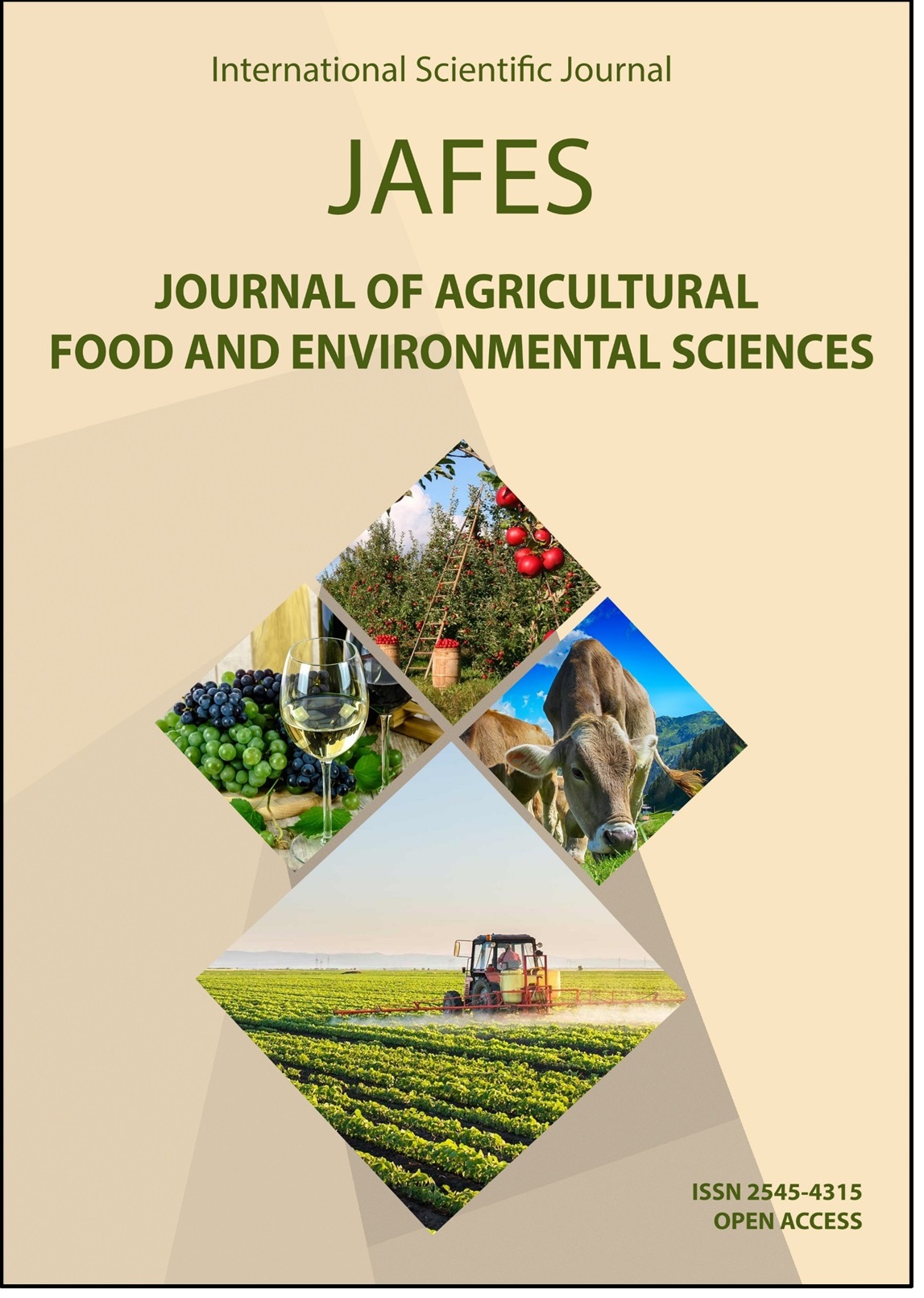The MOLECULAR CHARACTERIZATION AND GENETIC VARIABILITY IN BREAD, DURUM AND DICOCCUM WHEAT GENOTYPES BASED ON MICROSATELLITE MARKERS
Клучни зборови:
wheat, hybrid lines, cluster, microsatellites, variability.Апстракт
Tetraploid wheat species Triticum durum Desf. and Triticum dicoccum Schrank ex Schubler could be unique sources of favorable genes for economically important characteristics like resistance to biotic and abiotic stresses as well as quality characteristics. Molecular characterization and determination of genetic relationship among varieties and hybrid lines of bread, durum and emmer wheat is fundamental for selection of genotypes with desirable traits resilient under climatic fluctuations and development of successful crop improvement programmes. In this study, ten simple sequence repeat (SSR) markers were used to characterize 50 bread, durum, dicoccum wheat genotypes from North Macedonia. In total, 48 alleles were detected with an average of 4.8 alleles per locus. The highest number of alleles per locus was detected in genome D with 5.5, compared to 4.75 and 4.5 for genomes B and A, respectively. The mean PIC values for all 10 microsatellite markers was 0.66 with values ranging from 0.59 for marker Wmc264 to 0.85 for marker Wmc89 that are important for breeding programs. The average genetic diversity based on SSR markers was 0.51 with a range of 0.20 - 0.72. A dendrogram was constructed to determine the genetic relationship and cluster analyses separated tetraploid wheat from hexaploid wheat genotypes. The data could serve as a basis for wheat taxonomy,wheat improvement programmes and further association mapping for important agronomic traits.
Референци
Babay E, Chaabane R, Mzid-Abdmouleh R, Ben Naceur M. 2015. Diversity of tunisian bread wheat genotypes revealed by Morpho-agronomical and microsatellite markers. Bioscience Journal 31(3) , 701-708.
Christov Nikolai, Tsonev Stefan, Dragov Rangel, Taneva Krasimira, Bozhanova Violeta, Todorovska Georgieva Elena. (2022) Genetic diversity and population structure of modern Bulgarian and foreign durum wheat based on microsatellite and agronomic data. Biotechnology & Biotechnological Equipment 36:1, pages 637-652.
Ehtemam, M.H., Rahiminejad, R.M.,Saeidi,H., Tabatabaei, B.S.,. Krattinger,G.S., Keller, B., (2010). Relationships among the A Genomes of Triticum L. Species as Evidenced by SSR Markers, in Iran. Int J Mol Sci,11,11,4309–4325.
Ganeva, G., V., Korzun (2012): Microsatellite genetic diversity analysis and allelic variation comparison of obsolete and modern Bulgarian bread wheat (Triticum aestivum L.) varieties. Cereal Res. Comm., 40:14–23.
Hao C, Wang L, Ge H, Dong Y, Zhang X (2011) Genetic Diversity and Linkage Disequilibrium in Chinese Bread Wheat (Triticum aestivum L.) Revealed by SSR Markers. PLoS ONE 6(2): e17279.
Leonova, I. N., Badaeva, E. D., Orlovskaya, O. A., Roder, M. S., Khotyleva, L. V., Salina, E. A., Shumny, V. K. (2013). Genetika, 49(11), 1276–1283.
Li XJ, Xu X, Yang XM, Li XQ, Liu WH, Gao AN, et al. Genetic diversity among a founder parent and widely grown wheat cultivars derived from the same origin based on morphological traits and microsatellite markers. Crop Pasture Sci. 2012;63:303–10
Liu K, Muse SV. powerMarker: an integrated analysis environment for genetic marker analysis. Bioinformatics. 2005;21(9):2128–2129.
Machery- Nagel,(2014). Genomic DNA from plant. User Manual NucleoSpin Plant II,July 2014 /Rev.09.
Manasievska Simic, S., (2006). Polymorphism of glutenins, gliadins and yield components in wheat hybrids from species Tr.durum,, Tr. aestivum and Tr. dicoccum. Doctoral dissertation, Skopje.
Monneveux, P., Jing, R., Misra, S.C.,(2012). Phenotyping for drought adaptation in wheat using physiological traits. Frontiers in Physiology, 3, 429.
Orlovskaya, O.A., Koren’, L.V., and Khotyleva, L.V., Cytological characteristic of wheat hybrids produced by remote hybridization in the Triticeae tribe, Izv. Nats. Akad. Nauk Belarusi, 2011, no. 4, pp. 50–55.
Pascual L, Ruiz M, López-Fernández M, Pérez-Peña H, Benavente E, Vázquez JF, Sansaloni C, Giraldo P. Genomic analysis of Spanish wheat landraces reveals their variability and potential for breeding. BMC Genomics. 2020 Feb 4;21(1):122.
Pour Aboughadareh, A.; Kianersi, F.; Poczai, P.; Moradkhani, H. Potential of Wild Relatives of Wheat: Ideal Genetic Resources for Future Breeding Programs. Agronomy 2021, 11, 1656.
Röder MS, Plaschke P, König SU et al. Abundance, variability and chromosomal location of microsatellites in wheat. Mol Gen Genet 246: 327-333, 1995
Raza A, Mehmood SS, Shah T, et al. 2019. Applications of molecular markers to develop resistance against abiotic stresses in wheat. In: Hasanuzzaman M, Nahar K, Hossain M, editors. Wheat production in changing environments. Singapore: Springer, 393–420
Sonmezoğlu, O.A., Bozmaz, B., Kandemir, N., Aydin, N. (2012). Genetic characterization of Turkish bread wheat landraces based on microsatellite markers and morphological characters. Turk J Biol, 36, 589-597.



